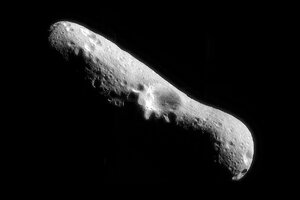'Wet' asteroids could serve as interplanetary rest areas
The recent discovery of an asteroid wrapped in ice suggests that astronauts could stop at space rocks for washing and refueling.

This NASA photo taken in 2000 shows the north pole of the asteroid Eros.
NASA/AP/File
The recent discovery of an asteroid wrapped in a layer of water ice has revived the possibility that some space rocks would be great potential pit stops – as well as destinations – for manned or robotic exploration missions.
If a space destination has water, that means astronauts traveling there could potentially use it for drinking and washing. But much more importantly, the water could be broken down into its component parts (hydrogen and oxygen) to make rocket fuel, experts say.
"Water is the main component in how you might make propellants," said Jerry Sanders, leader of in-situ resource utilization at NASA's Lunar Surface Systems Office at the Johnson Space Center in Houston. "If you're going to go repeatedly to an asteroid, then the ability to basically start setting up gas stations could be extremely beneficial."
Researchers announced last week that they had found definitive proof of frozen water, along with organic compounds, coating the surface of the large asteroid 24 Themis in the asteroid belt between Mars and Jupiter. Previously, scientists had believed that asteroids there were too close to the sun to harbor water without it evaporating away.
In addition to the practical benefit, water means that the site may potentially be habitable to life, which boosts the asteroid's scientific appeal as well. Although there's no sign yet that this or any other spot in the universe hosts extraterrestrials, the presence of water is the first thing researchers look for when scouting out where potential alien neighbors may reside.
President Barack Obama has set the goal of sending astronauts to a nearby asteroid by 2025. But those close space rocks would likely not have water ice since they would be even closer to the sun than the asteroid belt.
Space gas stations
Even small amounts of water on the surface of a planet or asteroid can bring big benefits for visiting missions.
For manned missions, a source of water for drinking and for extracting oxygen to breathe would be good as a backup, though hopefully closed-loop life-support systems could recycle most of the initial supplies, Sanders said. The real payoff of water would be in the possibility of using it to make fuel, said he added.
To extract the water, astronauts or robots would collect samples of the dirt or rock and grind them up into a powder. Then, the material would need to be heated – possibly with a microwave – to drive off the water so it can be collected. Finally, the water must be cleaned so that few impurities are left.
Once these steps are taken and a sample of water is available, actually turning it into rocket fuel isn't that hard, Sanders said.
"Actually how you convert water into fuels is a fairly easy and straightforward process," he told SPACE.com.
Water, or H2O, contains both hydrogen and oxygen, two of the most commonly used elements in propellant. To get to these raw building blocks, water must be broken down through a process called electrolysis. Electrolysis units are fairly standard pieces of equipment that are often used in life-support systems.
While a significant amount of equipment would be needed for the whole process, ultimately the hardware would take up much less room and weight than packing all the fuel needed for the return journey to Earth, not to mention any other excursions taken after first landing on the asteroid.
"If you have to do a long trip somewhere and you have to carry all the gas with you to go to that destination and come home, your fuel tank gets larger and larger, which means your vehicle gets larger, and you need a more powerful engine to pull the load," Sanders said.
Weightless challenges
The main challenge in extracting water from an asteroid would be dealing with the lack of gravity, Sanders said. Even places like the moon, which have 1/6 the gravity of Earth, would be easier to work on thanks to that modicum of gravitational pull toward the surface.
"Gravity helps you control where solids are and it helps you control the movement of those kind of resources in and out of your processing chamber," Sanders said. "It's not impossible to come up with ways of moving, but it's different than how we've done it up to this point."
Additionally, the spacecraft would have to find a good way to anchor securely to the surface without the help of gravity.
To find out if 24 Themis or any other asteroid is a promising spot for visiting, and initial prospecting mission is a good idea. Such a mission could take a closer look and analyze samples to determine whether there is enough water in a usable form to merit building a space gas station there.
